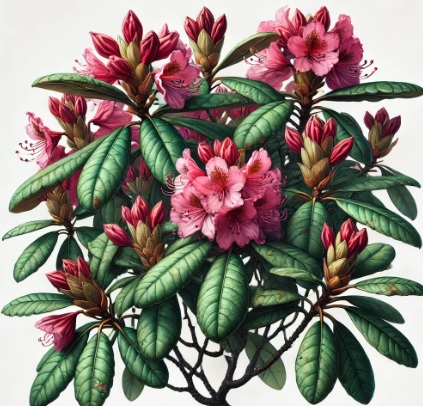Rhododendron ferrugineum, commonly known as the rusty-leaved rhododendron or alpine rose, is a species of rhododendron native to the mountainous regions of Europe, particularly the Alps and the Pyrenees. This evergreen shrub is notable for its attractive foliage and vibrant flowers, which add beauty to alpine landscapes and gardens.
Botanical Classification:
- Kingdom: Plantae
- Order: Ericales
- Family: Ericaceae
- Genus: Rhododendron
- Species: Rhododendron ferrugineum
Plant Characteristics: Rhododendron ferrugineum is characterized by:
- Size and Shape: A compact, low-growing evergreen shrub typically reaching heights of 0.5 to 1 meter. It has a dense, rounded form.
- Leaves: The leaves are small, lance-shaped, and covered with a rusty-brown indumentum (fine hairs) on the underside, giving them a distinctive appearance. The upper side is dark green and glossy.
- Flowers: The flowers are bell-shaped, usually in shades of pink or red, and appear in dense clusters. They bloom in summer, typically from June to July, adding a vibrant splash of color to alpine meadows and rock gardens.
- Fruit: The fruit is a small capsule that releases seeds when mature, aiding in reproduction and dispersal.
- Soil and Light: Prefers acidic, well-drained soils and thrives in full sun to partial shade. It is well-adapted to rocky, alpine environments and can withstand cold temperatures.
Chemical Composition and Structure: The chemical composition of Rhododendron ferrugineum includes:
- Flavonoids: Includes compounds such as quercetin and kaempferol, which are known for their antioxidant properties.
- Tannins: Present in the leaves and bark, providing astringent qualities.
- Essential Oils: Found in small quantities, contributing to the plant’s aromatic profile.
- Phenolic Compounds: These contribute to the plant's potential health benefits and flavor profile.
Uses and Benefits:
- Aesthetic: Valued for its attractive flowers and evergreen foliage, making it a popular choice for ornamental gardens, particularly in alpine or rock gardens.
- Cosmetic: While not commonly used in commercial cosmetics, the plant’s extracts may offer some potential benefits due to its antioxidant properties.
- Medicinal: Traditionally used in herbal remedies in some cultures, particularly for its potential anti-inflammatory and astringent properties. However, scientific evidence supporting medicinal uses is limited.
- Ecological: Plays a role in alpine ecosystems by providing habitat and food for various wildlife species.
Applications:
- Gardening: Ideal for alpine gardens, rock gardens, and as ground cover in acidic soil environments. Its vibrant flowers and evergreen foliage enhance garden aesthetics.
- Cosmetics: Potential use in natural cosmetics due to its antioxidant properties, though not widely utilized.
- Medicinal: Used in traditional remedies for its potential anti-inflammatory and astringent effects. Research on these uses is limited.
- Ecological: Contributes to biodiversity in alpine ecosystems and supports local wildlife.
Cosmetics - INCI Functions
Fragrance. It plays a very important role in the formulation of cosmetic products as it provides the possibility of enhancing, masking or adding fragrance to the final product, increasing its marketability. It is able to create a perceptible pleasant odour, masking a bad smell. The consumer always expects to find a pleasant or distinctive scent in a cosmetic product.
Skin protectant. It creates a protective barrier on the skin to defend it from harmful substances, irritants, allergens, pathogens that can cause various inflammatory conditions. These products can also improve the natural skin barrier and in most cases more than one is needed to achieve an effective result.
CAS 90106-21-1
EC number 290-243-0
Environmental and Safety Considerations:
- Environmental Impact: Non-invasive and beneficial for alpine and rocky garden settings. It supports local biodiversity and provides habitat for wildlife.
- Safety: Generally safe for handling. However, as with all plants, care should be taken to avoid ingestion of non-edible parts, which could cause digestive upset. Consult a healthcare provider before using the plant for medicinal purposes.
![]() Rhododedron Ferrugineum
Rhododedron Ferrugineum 

